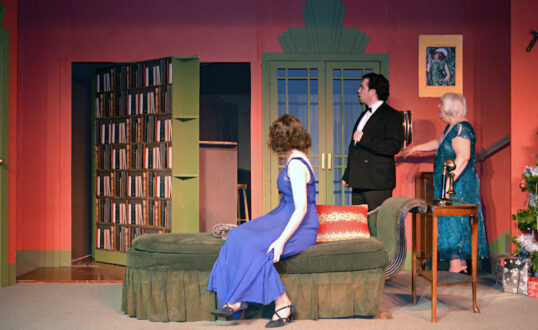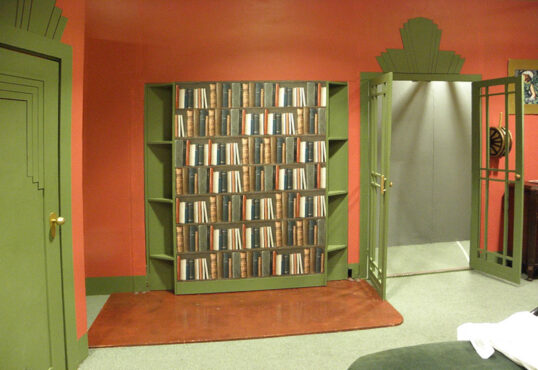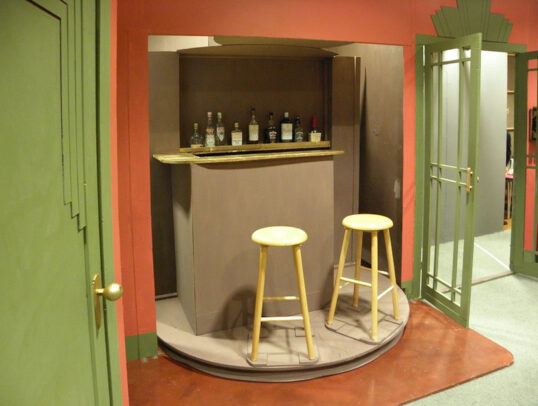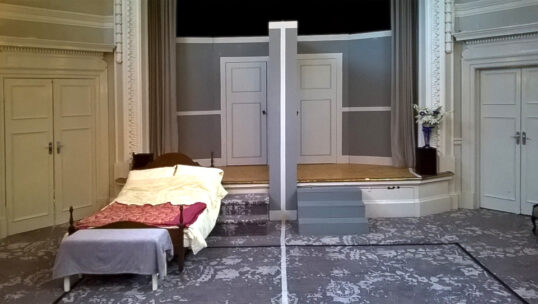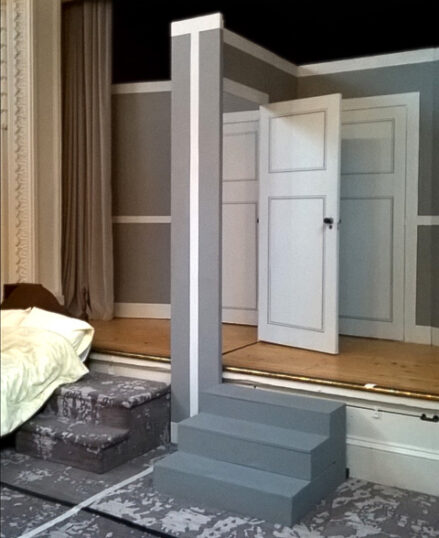The Joy of Sets
The challenges and rewards of set building
The Edinburgh Makars are looking for a volunteer to take the lead on set design and construction, as their current set builder, Alasdair Taylor, is looking to step down from the role to pursue other interests.
The well-regarded amateur company are now looking for a someone to take over Alasdair’s role. This involves taking the lead in liaising with the director on the design of the set and then organising the building of it with other volunteers. Anyone interested should contact the club secretary, Frank Skelly: here.
Alasdair Taylor has written up a set of notes in which he describes and talks about some of his most memorable builds. Originally published on the Makars’ website as guide to anyone who might want to volunteer for the role, he has been kind enough to let us publish it in full. It is a real eye-opener for those of us who just see the work of an amateur company from the stalls; and a fascinating read to gain new insight into the process of getting a play on stage.
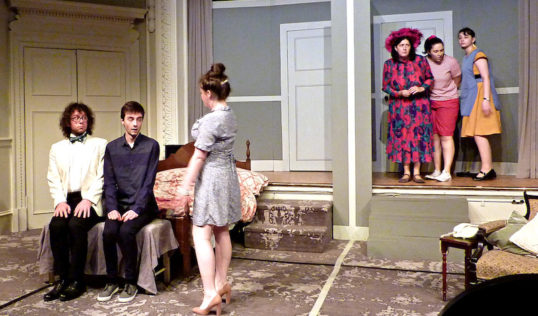
Alasdair Taylor’s set for Perfect Wedding (2019) in action at the Royal Scots Club, showing Robert Wyllie, Alex Fleming, Lucy Wilson, Emma Swift, Ailie Henderson and Georgia Smith. Pic Martin Burnell
I joined the Makars (as the club was then) in late 1988 and, apart from a few minor “Inspector Plod” or “glaikit retainer” acting roles, most of my involvement since then has been as stage crew. During the last 10 years or so I’ve been the stage-carpenter / set-designer for most of the club’s major productions, having done something similar for Edinburgh University Savoy Opera Group for a time in the 1980s.
It all usually starts with a phone call or email from the director who has been appointed for the chosen forthcoming play, along the lines of “Alasdair, I need a set for the XYZ play – are you prepared to organise it? It’s got to feature a….” So then follows a preliminary meeting with said director, when he/she says what they want, the stage crew tell them what they can have, and we negotiate from there to evolve a suitable set design for the venue which has been booked.
Murrayfield Parish Church Centre
We’ve mounted fully-staged productions in a number of venues within Edinburgh over the years. For a long time the venue for our August Festival Fringe production was the Murrayfield Parish Church Centre in west central Edinburgh, which we took for a fortnight each year. The hall was spacious enough to enable us to finish constructing and painting the set before assembling it on the stage, but there was no in-house stage lighting and this had to be hired in for the duration.
The stage was a relatively small one so we usually concentrated on single-set productions, with little or no scene change between acts, other than perhaps furniture or props. In a theatrical context the ceiling is quite low (just under 11 feet) so the club put together a range of 10-foot-high flats (doors, windows and plain wall flats of various widths) from which to construct the relatively simple box-sets we used there.
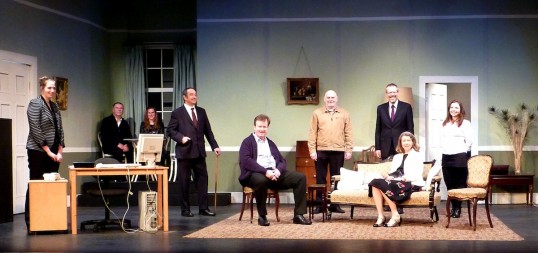
The set for A Touch of Danger (2015) at the Church Hill Theatre. With Grace Gilbert, Phil McNicol, Emma Needs, Chester Parker, Derek Melon, Andrew Hawdon, Beatrice Cant and Pamela de Logu. Pic: Edinburgh Makars
The other main venue we’ve used regularly is the Church Hill Theatre, run by Edinburgh Council. This is actually a former church (converted in the 1960s) – with a spacious stage, lighting facilities and several dressing-rooms it’s a firm favourite with longer-serving club members.
There’s plenty of height onstage so we can easily use full 12-foot flats to construct box- (or semi-box) sets as required. Its main disadvantage is the seating capacity of around 350, which really means that whatever play is chosen has to be potentially good box-office, to attract reasonable audiences for a run of 3 or 4 nights and at least break even.
Royal Scots Club
Since 2016 we’ve put on our August Festival Fringe production in the Hepburn Suite at the Royal Scots Club in Abercromby Place. Its main advantage is it has a more city-central location than Murrayfield Parish Church, and the fact that the audience seating and stage lighting set-up is provided for us.
Being quite a small venue, the RSC has brought its own challenges: the “stage” itself is quite small, but the front part of the auditorium floor area can also be used for acting – see the pictures above and below of the set for Perfect Wedding. The need to carry everything up the back staircase from the lane behind the building, when moving in and out, essentially restricts to 8 feet the maximum height of flats we can use.
The club is fortunate to have had for many years a sort of scenery-store-cum-workshop, rented from Edinburgh Council, and situated in the Canongate part of Edinburgh’s Royal Mile. The premises were once a small confectionery manufactory: it has electricity (lighting and power) but no water or drainage, or windows for light. For us, the place is something of an Aladdin’s Cave, containing our extensive collection of theatrical flats for walls, doors and windows, along with rostra, stage-braces, stage-weights and other elements of sets from shows gone by.
There’s a basic workbench along part of one wall which is home to a fairly extensive toolkit, a stock of timber of various sizes for set construction, shelving to store hardware such as door-handles, brackets, hinges and castors and a cupboard for storage of paint. But with a bit of careful organisation there is still room in the middle of the workshop to test-assemble parts of an under-construction set, to check that it all fits together before the move-in to the actual theatre. Assembly is usually by screwing the flats etc together, rather than by traditional ropes and cleats: if a set has to be dismantled during the run of a show, then we’ll use hinges with removable pins – see details for Perfect Wedding below.
reduce, re-use, recycle
The challenge is to produce our sets at minimum cost, but with the ethos of “reduce, re-use, recycle” we usually have something which can be re-purposed to fit the staging requirements. Other stage-crew members have kindly donated surplus items and materials from time to time, and it’s rare that we need to buy much in – our main expenditure on a forthcoming production is usually paint!
The two sets which I think gave me the most satisfaction are those for The Game’s Afoot by Ken Ludwig at Murrayfield Parish Church Centre in August 2015 and Perfect Wedding, a farce by Robin Hawdon, at the Royal Scots Club in Abercromby Place in 2019.
The Game’s Afoot
The set for The Game’s Afoot involved quite a complex Art Deco set, the centrepiece of which was a revolving bookcase/bar unit.
At one point this unit had to revolve with two comatose cast members leaning over the bar, so it had to be quite robust. The base was a semi-circle of something like 18mm plywood with a hidden central pivot pin in a PTFE bearing: this assembly was mounted on significant numbers of castors running on a baseboard (see pic) of 18mm chipboard painted with gloss paint, to facilitate smooth running. (Gloss paint is something we never normally use in set construction – it requires solvents for brush-cleaning and my preference has always been for emulsion paint, even if the lack of water or drainage in the Canongate store means the brushes have to be taken home for washing-out.)
The operating mechanism was a simple low-tech one, using a climbing-rope round the perimeter of the “circle” to haul the unit open on a given cue, and another rope run in the opposite direction through a small pulley-block to haul it closed again. The set received much critical acclaim, though in reality it was 90% basic DIY, with only 10% inspiration and ingenuity, and much to everyone’s relief it worked correctly during rehearsals – and every night for 10 performances!
Perfect Wedding
The challenge with Perfect Wedding at the Royal Scots Club was putting up and taking down the set every night, as the place was used by other Fringe productions during the day. It also had to be robust enough to cope with the traditional farce features of doors opening and shutting at frequent intervals!
Construction was facilitated by using hinges with removable pins or bolts and wing-nuts to assemble the flats together: the central “wall” between the 2 “rooms” had a door (to be opened and shut) but as it was centre stage there was no possibility of supporting this with traditional stage-braces and weights. So the solution was to reinforce the narrow flat seen in the centre with a floor-level cross beam – making an inverted “T” – held down with stage weights hidden behind the sets of steps seen here. That was the first piece to erect, followed by the central door wall, and the upstage door flats etc followed on from that.
Of course, none of this would have been possible without other members of the Edinburgh Makars as stage crew – it’s a team effort, and my grateful thanks to all those who have provided stalwart assistance over the years!
While I’m effectively stepping back from the lead role here, I would be willing if need be to give some guidance / act as a consultant to whoever takes on the role, and maybe from time to time turn out to help with construction and undertake an ASM role backstage for future productions.
If you are interested please contact our Secretary, Frank Skelly: here.
Alasdair Taylor
ENDS










